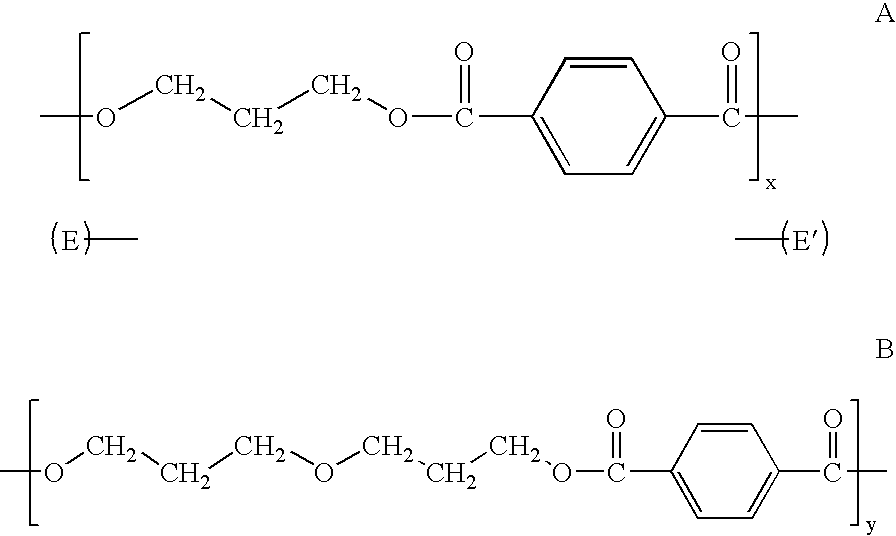Process for producing polytrimethylene terephthalate
- Summary
- Abstract
- Description
- Claims
- Application Information
AI Technical Summary
Problems solved by technology
Method used
Image
Examples
example a (comparative)
[0082] A 5 litre reactor equipped with a helical stirrer, hot oil heating, distillation column and vacuum capability was charged with 1934 g of terephthalic acid (TPA), 0.6 g Irganox 1076 stabilizer (commercially available from Ciba), 8.5 g of a 1,3-propanediol (PDO) solution containing cobalt acetate and silicon antifoam agent (commercially available from Dow Corning) (15 ppm Co based on weight of final polymer and 0.5 ppm antifoam agent based on weight of final polymer), 2.0 g of a PDO / acetic acid solution of titanium butoxide catalyst (15 ppm Ti based on weight of TPA) (commercially available from Aldrich Chemical) and 1131 g of PDO.
[0083] The esterification step was conducted by pressurizing the reactor to about 30 psig (1551 torr), stirring at about 150 rpm and heating to 255-260° C. for a total of about 120-140 minutes while distilling off the water produced in the reaction and some of the excess PDO. The reactor was returned to atmospheric pressure and an additional 8.8 gm o...
examples 1 to 3
[0085] Examples 1 to 3 were performed in the same way as for Comparative Example A, except that the protic acid, para-toluenesulfonic acid monohydrate (p-TSA) (commercially available from Aldrich Chemicals), was included in the esterification step of the process. The solid p-toluenesulfonic acid was added along with the initial charge of TPA and PDO into the reactor. The intrinsic viscosity and the amount of p-TSA added is indicated in Table 1. The amount of DPG comonomer units present in the final PTT product is indicated in Table 1.
TABLE 1p-TSADPGmmole / KgIVmoleDPGExamplegppmPTT*g / dL%**wt %A0000.712.71.510.024100.0520.713.41.920.036150.0770.714.22.430.12500.260.728.94.9
*based on 2.4 kg theoretical yield of PTT.
**based on the total number of moles of diol units.
[0086] Table 1 shows that the amount of DPG in the final PTT product is significantly increased when p-TSA is added to the esterification step (Examples 1-3) compared to when no p-TSA is added (Example A).
[0087] It can al...
PUM
| Property | Measurement | Unit |
|---|---|---|
| Temperature | aaaaa | aaaaa |
| Substance count | aaaaa | aaaaa |
| Concentration | aaaaa | aaaaa |
Abstract
Description
Claims
Application Information
 Login to View More
Login to View More - R&D Engineer
- R&D Manager
- IP Professional
- Industry Leading Data Capabilities
- Powerful AI technology
- Patent DNA Extraction
Browse by: Latest US Patents, China's latest patents, Technical Efficacy Thesaurus, Application Domain, Technology Topic, Popular Technical Reports.
© 2024 PatSnap. All rights reserved.Legal|Privacy policy|Modern Slavery Act Transparency Statement|Sitemap|About US| Contact US: help@patsnap.com









